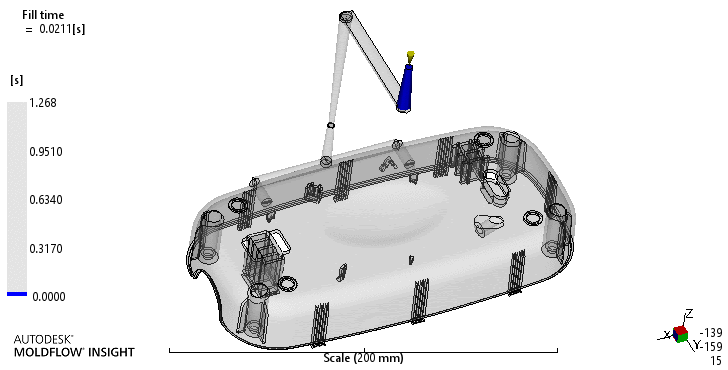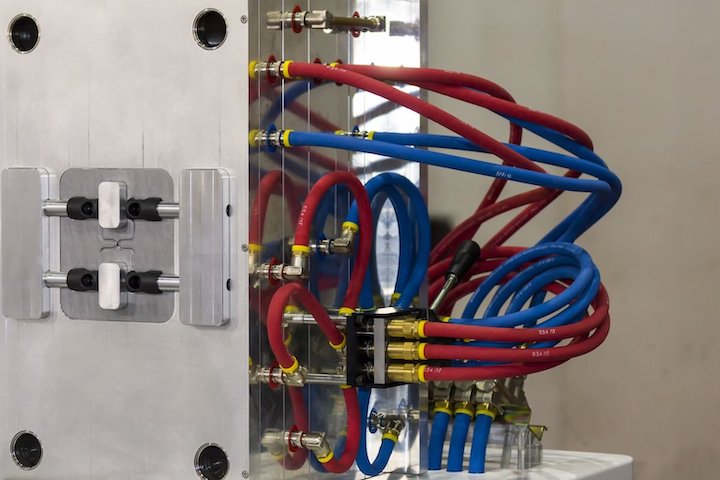Time to read: 7 min
Mold flow analysis is a software-based simulation that predicts how a plastic resin will flow into and fill an injection mold. It also accounts for part cooling and process optimization. There are other ways to analyze the injection molding process, but modeling it is faster, less expensive, and more efficient than machining metal plates, building an injection mold, running sample parts, and then modifying the tool.
Mold flow analysis also helps designers avoid mistakes leading to injection molding defects such as short shots, sink marks, and warpage. By making informed decisions early in the design phase, you can get better-quality injection molded products with lower costs and faster turnaround times. Mold makers and injection molders can also benefit from reviewing mold flow data.
This article explains how mold flow analysis improves injection molding outcomes through the early detection and resolution of potential problems. It begins with a discussion about mold flow analysis software, describes mold flow DFM for quality plastic parts, and ends with a success story from a medical device company.

Mold Flow Analysis Software Options
Autodesk mold flow is the most widely used software for simulating the plastic injection molding process. This product has two main versions: Mold Flow Adviser and Mold Flow Insight. Mold Flow Adviser is available in Premium and Ultimate versions, and Mold Flow Insight comes in Standard and Premium versions. Each application has distinctive features, but they can all import CAD files with geometric data.
There are other types of mold flow analysis software as well. Options include SolidWorks Plastics, Moldex3D and CoreTech Moldex3D, Sigmasoft, and Simcon simFLOW. Creo mold flow analysis and ANSYS mold flow software are also available. This article does not recommend software or provide usage instructions. Rather, it explains how a robust mold flow analysis can improve injection molded parts.
It’s also possible to avoid investing in mold flow analysis software altogether by requesting a low-cost mold flow analysis from Fictiv during the quoting process. Get started by uploading your design today.
Mold Flow DFM for Quality Plastic Parts
Mold flow analysis software supports design for manufacturability (DFM) in six important ways.
- Material Selection
- Mold Design Optimization
- Filling Analysis
- Flow Analysis
- Warpage Analysis
- Process Optimization
The following sections explain.
Material Selection
mold flow software lets users model the behavior of different plastic resins throughout the entire injection molding process. As a designer, you can then use this information to select the plastic material most likely to produce the best injection molded parts. For example, because resins like polycarbonate (PC) tend to flow poorly, you may decide to use acrylic with complex molds and part designs.
Material Database
mold flow software often includes a database of various plastic materials’ rheological properties, thermal properties, and other flow-related characteristics. Because there are thousands of different resins, including commodity plastics, specialty plastics, and polymer blends, a comprehensive database is an asset for part designers.
Material Analysis
Mold flow software with material analysis capabilities lets you specify individual properties (such as rheology) or select materials based on these characteristics. The software then uses this information to simulate how the plastic resin will behave at each stage of the injection molding process, from clamping and injection to dwelling and cooling.
Comparative Analysis
Depending on the type of mold flow software, users who simulate multiple materials may be able to compare the results side-by-side. This supports informed decision-making based on factors such as part quality, production efficiency, and per-part cost. If a mold flow analysis indicates a potential defect, finding a suitable replacement material can save you time and money.

Mold Design Optimization
Injection molds are usually made of steel or aluminum. Steel molds are more expensive, but they last longer, produce parts with tighter tolerances, and come in soft, semi-hardened, and hardened grades. Mold design optimization begins with mold material selection but also accounts for runners, gates, and cooling lines. These three components are also key to your injection molding success.
Mold Material Selection
mold flow analysis simulates the transfer of heat during the injection molding process. Because different plastics melt at different temperatures and because excessive heat can cause polymers to degrade, it is essential to understand how a mold’s thermal performance could affect your parts. If mold temperatures are too high, plastic could stick to the mold. If the mold temperature is too low, sink marks could result.
Runner System Design
Runners are networks of channels that convey molten plastic to the mold’s cavity. They are either heated (hot runners), unheated (cold runners), or insulated. mold flow analysis helps determine the optimal runner type, size, shape, and layout for uniform filling and reduced pressure drops. Hot runners provide greater flow control but may not be suitable for some heat-sensitive polymers.
Gate Location Optimization
Gates are openings in the mold that allow molten plastic to enter the cavity. They also control the direction and volume of flow. By analyzing potential gate locations, mold flow analysis software can suggest where to put gates so the mold fills evenly and completely. A mold flow analysis may also account for gate freeze and the time required to prevent backflow.
Part Cooling Analysis
Cooling lines guide a cooling medium through the mold. Air cooling uses an evaporator to remove heat. Water cooling pumps coolant through lines on the outside of the cavity. mold flow software simulates the cooling phase of the injection molding process and predicts temperature distributions and cycle times. Because 80% of the injection molding cycle involves cooling, faster cooling helps to control costs.

Filling Analysis
A filling analysis determines how molten plastic material will fill the cavity during injection. This information can indicate potential problems such as air entrapment or incomplete or uneven filling. A mold maker can then modify the tool’s design to minimize the risk of short shots, and the failure of the molten plastic to fill the entire mold cavity.
Flow Analysis
The leading edge of a mold flow may encounter obstacles that cause the flow to separate. Examples include the core pins used to produce holes in molded parts. When the two flow fronts come together again, they might not mix because partial cooling has occurred. Flow analysis accounts for flow patterns and can help to avoid injection molding defects called weld lines.
Warpage Analysis
A warpage analysis can identify potential problems caused by non-uniform cooling and uneven internal shrinkage. Mold makers can use this information to modify tooling, and designers can use it to minimize areas of high stress or to change wall thickness or part geometry. Fictiv’s Injection Molding Design Guide is filled with expert information you can use for your next plastics project.
Download the Injection Molding Design Guide
Process Optimization
Like part designers and mold makers, injection molders can benefit from mold flow analysis. For example, a molder may consider mold flow data when adjusting the injection pressure, holding pressure, melt temperature, and packing pressure for a production run.
- Injection pressure is the pressure at which the injection mold is filled.
- Holding pressure is the pressure at which the filled mold is held until gate freeze occurs.
- Melt temperature is the temperature of molten plastic as it enters the mold.
- Packing pressure fully compresses the plastic as it cools and shrinks in the mold.
The final section of this article contains a mold flow analysis success story with a Fictiv customer.
Mold Flow Analysis Success Story
A medical device company wanted to injection mold parts made of nylon, a popular plastic with good mechanical strength and thermal performance. However, an initial run yielded parts that were slightly warped. Subsequent testing determined that flatness was critical for part function. Designers at the medical device company then requested engineering changes (ECs) prior to a second test run of parts.
Although the second run yielded better parts than the first, the second batch still didn’t pass testing. Design changes, new cooling fixtures, and modifications to injection molding tool parameters were not enough. Fictiv then suggested a mold flow analysis comparing injection molded nylon to a polymer blend made of polycarbonate and acrylonitrile butadiene styrene (PC+ABS).
PC/ABS is one of the world’s most widely used engineering thermoplastics. It’s strong, stiff, and heat resistant with high impact resistance, even at low temperatures. During processing, this polymer blend has low shrinkage, which results in fewer injection molding defects. Typically, PC/ABS is used in the automotive industry for glove boxes and in the electronics industry for laptop monitor enclosures.
The medical device company agreed to consider PC/ABS, so Fictiv ran a mold flow analysis that compared this material to nylon. The results indicated that PC+ABS parts would exhibit less deflection, and without compromising part strength. Based on Fictiv’s advice, the medical device company modified its design to use PC+ABS. New tooling was required, but the customer received the precision parts that it needed.
Complex Parts at Amazing Speeds
Fictiv supports new product introduction (NPI) efforts like this by delivering complex parts at amazing speeds. Mold flow analysis is just some of the value that we provide. Customers gain access to our carefully vetted network of global manufacturing partners, but the benefits begin even earlier. After you upload your part design to Fictiv, you’ll get expert DFM feedback that can reduce costs and accelerate timetables.
Are you ready to get started with your injection molding project, including a mold flow analysis? Create a free Fictiv account and upload your part design today.










